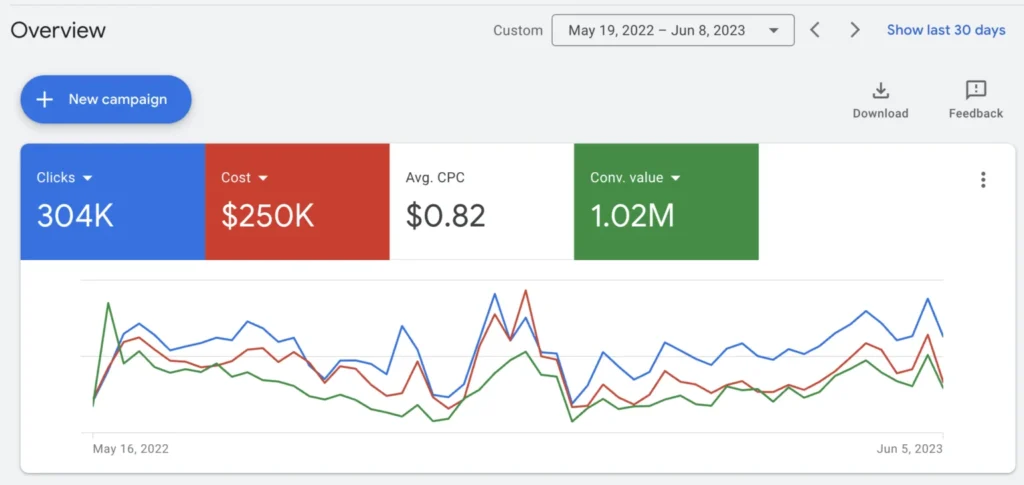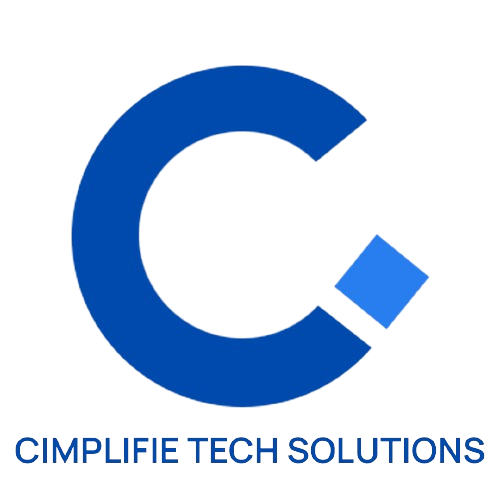Cimplifie partnered with a US-based fashion brand to enhance its online presence and drive revenue growth through Google Ads. By implementing a strategic Google Ads campaign, we successfully transformed their digital advertising efforts, achieving over $1 million in revenue within 12 months.

Through our targeted approach, continuous optimization, and data-driven decision-making, we maximized return on investment (ROI) and helped the brand scale profitably. Our Google Ads case study highlights the key strategies that contributed to this success and provides actionable insights for eCommerce brands looking to optimize their paid advertising efforts.
The Challenge: Overcoming Competition & Scaling Profitably
The eCommerce fashion industry is highly competitive, requiring brands to differentiate themselves in a crowded market. Initially, this fashion brand primarily relied on Meta Ads (Facebook & Instagram Ads) to drive traffic. However, they wanted to expand their reach and leverage Google Ads as an additional marketing channel.
The core challenges included:
- Increasing brand visibility through Google Search & Display Ads.
- Driving qualified traffic that converts into paying customers.
- Scaling revenue while maintaining a profitable Cost Per Acquisition (CPA).
- Optimizing ad spend to ensure maximum returns from every dollar spent.
Cimplifie stepped in with a comprehensive Google Ads strategy designed to overcome these challenges and unlock new growth opportunities for the brand.
Our Strategy: Data-Driven Google Ads Optimization
1. Audience Targeting & Market Research
Before launching the campaign, we conducted in-depth audience research to identify the brand’s ideal customer profiles. We then implemented:
Demographic Targeting – Adjusting bids based on age, gender, and income levels.
Geographic Targeting – Focusing on high-converting locations.
Interest-Based Targeting – Reaching users interested in similar fashion brands.
By refining our targeting parameters, we ensured that ads were shown only to potential customers with a high likelihood of conversion.
2. Keyword Research & Optimization
Our next step was to identify high-intent keywords related to the brand’s products. Using Google Keyword Planner and third-party tools, we:
Researched long-tail keywords that indicated strong purchase intent.
Segmented keywords based on search volume and competition level.
Integrated keywords into ad copy, landing pages, and product feeds.
This keyword-first approach helped increase ad relevance and Quality Score, reducing overall cost per click (CPC).
3. Leveraging Performance Max (pMax) Campaigns
Google’s Performance Max (pMax) campaigns use AI to optimize ad placements across multiple Google channels. We:
Tested different ad creatives to maximize engagement.
Allowed Google AI to optimize bids for high-converting users.
Expanded reach across Search, Display, YouTube, and Shopping Ads.
By automating ad placements, we increased efficiency and reduced wasted ad spend.
4. Implementing Smart Shopping Campaigns
To further boost eCommerce sales, we leveraged Smart Shopping campaigns powered by Google’s machine learning algorithms. These campaigns:
Showcased products dynamically across Google Shopping, Search, and Display networks.
Targeted high-intent shoppers who were ready to purchase.
Maximized conversions by automatically adjusting bids based on user behavior.
5. Enhancing Ad Creatives with Ad Extensions
To improve ad engagement, we utilized:
Sitelinks – Directing users to specific product categories.
Callout Extensions – Highlighting key selling points like “Free Shipping.”
Structured Snippets – Showcasing different product styles & collections.
These ad extensions increased click-through rates (CTR) by making ads more informative and visually appealing.
6. Remarketing & Retargeting Campaigns
To re-engage potential buyers, we launched dynamic remarketing campaigns targeting users who had:
Visited the website but didn’t purchase.
Abandoned carts before checkout.
Viewed specific product pages.
Using custom remarketing lists, we tailored ad creatives to remind users about products they showed interest in. Additionally, we integrated email & SMS campaigns to recover lost sales and drive repeat purchases.
7. Conversion Rate Optimization (CRO) & Landing Page Updates
Beyond Google Ads, we improved on-site experience to increase conversions:
- Optimized product pages with clear CTAs and engaging copy.
- Improved page load speed for a seamless shopping experience.
- Refined checkout process to reduce cart abandonment.
These changes enhanced overall conversion rates, making the Google Ads campaigns even more profitable.
Results: Achieving a 400% ROI on Google Ads
By implementing strategic targeting, data-driven bidding, and continuous optimization, we helped the brand achieve outstanding results.
📊 Key Performance Metrics:
- Total Ad Spend: $250,000
- Revenue Generated: Over $1 million
- Return on Investment (ROI): 400%
- Improved CPA: Lower acquisition costs with better targeting
- Higher Engagement: Increased website traffic & conversion rates
- Enhanced Retention: Repeat customers through email & SMS marketing
Our Google Ads case study proves that with the right strategy, brands can scale profitably while optimizing ad spend.
Google Ads Case Study: Key Takeaways for eCommerce Brands
For brands looking to grow with Google Ads, here are some key best practices:
1️⃣ Set Clear Goals – Define KPIs such as sales, ROAS, or website traffic.
2️⃣ Optimize Ad Copy – Use strong CTAs and engaging headlines to boost CTR.
3️⃣ Target the Right Audience – Utilize demographics, interests, and remarketing.
4️⃣ Refine Keyword Strategy – Focus on high-intent, high-converting keywords.
5️⃣ Leverage AI-Powered Campaigns – Use pMax and Smart Shopping.
6️⃣ Improve Landing Pages – Ensure fast loading speeds & optimized checkout.
7️⃣ Track & Analyze Performance – Use Google Analytics & conversion tracking.
8️⃣ A/B Test Regularly – Optimize ad creatives & targeting based on data.
9️⃣ Scale with Remarketing – Re-engage lost visitors with personalized ads.
🔟 Monitor & Adapt – Stay updated with Google Ads trends & competitor strategies.
Implementing these best practices will help brands maximize ROI, reduce ad waste, and scale eCommerce growth.
Conclusion: The Power of Google Ads for eCommerce Growth
This Google Ads case study showcases the power of targeted advertising in achieving high ROI and substantial revenue growth for eCommerce brands. Through:
Data-driven keyword optimization
AI-powered campaign strategies
High-converting landing pages
Advanced remarketing techniques
Cimplifie successfully scaled a fashion brand from $250,000 ad spend to over $1 million in revenue.
If you’re looking to grow your eCommerce store with Google Ads, our team of experts is ready to help. Book a call today and let’s discuss how we can drive profitable growth for your brand!

